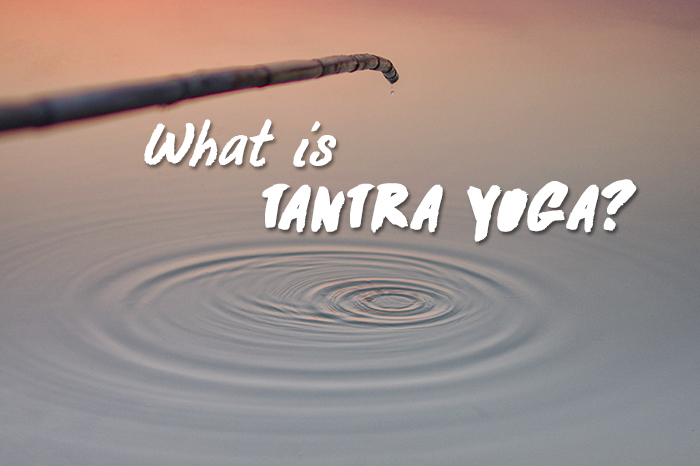What is Tantra Yoga?

A lot of associations may come to mind when you hear the words, “Tantra Yoga.” Some words that you make think of are sexual, intimate, weird, hippie, etc. The best way to overcome these negative perceptions are to become educated on the subject itself. Tantra is the ancient practice of a powerful combination of asana, mantra, mudra, and bandha (energy lock) and chakra (energy center) work that can be used to build strength, clarity, and siddhi (bliss) in everyday life.
Some believe that Tantra Yoga is more intricate and beneficial than other forms of yoga. Tantra Yoga requires harnessing and embodying the five forces of Shakti, the female deity that represents creativity and change. Tantric Yoga suggests that by harnessing the balance between yin and yang, we can move through the world with more confidence and contentment.
Lela Becker and Nicholas Goodman host a podcast and share their knowledge, perspective and experience of what Tantra Yoga is. Listen to their podcast below and then read on to better understand how Tantra is in everything we practice.
Tantra is the Study of Everything.
The yoga sutras are the threads of knowledge that suture together the written teachings of the philosophy of yoga. Tantra embodies those philosophies, a living expression of how we can incorporate those teachings into our everyday life.
“Tantra itself means “to weave, to expand, and to spread”, and according to tantric masters, the fabric of life can provide true and ever-lasting fulfillment only when all the threads are woven according to the pattern designated by nature.”
What is Yoga?
The word yoga means to yolk, to bind, to connect. The idea behind this system of discipline is to unite yourself with the divine nature of life, to remember your essential wholeness, and to dispel all illusions, pleasant or painful. These practices involve moral guidelines, physical practices, breath work, meditation, and immersion into the infinite.
Yoga itself manifests in many forms and thus we are attracted to practices such as Karma yoga (yoga of service), Raja yoga (royal yoga), Bhakti yoga (devotional yoga), Jnana yoga (intellectual yoga) and many more. All of these individual methods serve as ways to connect and remind us of our true nature – the root of who we are as individual beings.
Why is Tantra Different?
Tantra is different from most other styles of yoga practice because it places focus on the reprogramming of subconscious patterns and conditioning of our belief systems through intense self realization and meditational practices while moving through a gentle, yet challenging tridoshic balancing sequence. The word “tantra” literally means a technique or a technology. In Tantra yoga the practice becomes more mental than physical.
Tantra is not a philosophy that requires a modern-day practitioner to renounce all worldly practices – giving up family, job, possessions, and pleasures. Instead, Tantra emphasizes personal experimentation as a way to move forward on the path to self-realization.
Where Does Tantra Come From?
The root and core of the word can also be described with a mantra attached, “The word “tantra” is derived from the combination of two words “tattva” and “mantra”. “Tattva” means the science of cosmic principles, while “mantra” refers to the science of mystic sound and vibrations. Tantra therefore is the application of cosmic sciences with a view to attain spiritual ascendancy. In another sense, tantra also means the scripture by which the light of knowledge is spread: Tanyate vistaryate jnanam anemna iti tantram.
While most meditation and yoga practices are to expand the mind and come to a higher state of consciousness, Tantra Yoga’s main principle is to use the holistic approach while also drawing on sciences, astronomy, astrology, Ayurveda, psychology and sacred geometry to deprogram our brain and bring fresh awareness and an awakened state. According to Tantra, the human being is a miniature universe.
“Where can the curiosity to discover your True Self lead you?”
How can I learn more about Tantra Yoga?
If you’re curious and want to study Tantra yoga, there are books that can help you delve deeper into the history and practice. Tantra is rooted in Hindu philosophy, so start by getting familiar with the Veda’s and ancient Hindu texts and scriptures. The Atharva Veda is considered to be the prime tantric scripture.
Additional recommended Tantra literature:
Divine Initiation by Bhagavan Anantha Natha
The Serpent Power by John George Woodroffe
Tantra: The Path of Ecstasy by George Feurestein
The Great Book of Tantra by Indra Sinha
Tantra: The Art of Conscious Loving by Charles Muir
Tantra the Supreme Understanding by Osho
The Yoga of Power by Julius Evola
Kundalini Tantra by Satyananda Saraswati
The Tantric Way: Art, Science and Ritual by Ajit Mookerjee
The Undiscovered Self by Carl Jung
How do I Practice Tantra Yoga?
Yoga has various different forms – there’s the physical Asana (poses) practice of yoga, probably similar to what you practice in a studio or gym, there’s Bhakti yoga which is the practice of devotion, often through kirtan or service work, Karma Yoga which is the act of service, and many other forms. In Tantra yoga you practice the balance the four elements, earth, water, fire, air, through the fifth element, akasha. Akasha is the element that is the binding force between all elements. Harnessing the Akasha will result in the balance and connection to our divinity or atman (soul).
Tantra yoga is the oscillating balance between Shiva and Shakti, Yin and Yang, male and female, dark and light to find the balance within ourselves. Through Tantra yoga we find our truth and learn to live from it. Tantra yoga guides us to a path, that with a strong physical and mental practice, will lead us to absolute personal freedom.
[……]
